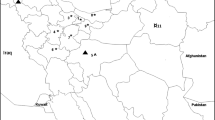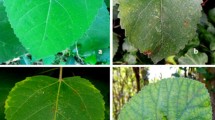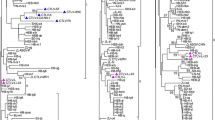Abstract
A survey of key Australian pome fruit growing districts for 11 quarantinable pathogens was conducted using reverse transcriptase polymerase chain reaction (RT-PCR) and PCR methods. The targeted exotic organisms included two bacteria, two phytoplasmas, four viroids and three viruses. Except for Pear blister canker viroid, which has been previously reported in Australia, no other exotic pathogen was detected. RT-PCR assays were also used to detect four endemic viruses, Apple stem pitting virus, Apple stem grooving virus, Apple chlorotic leafspot virus and Apple mosaic virus. The results showed that each virus is widespread in Australia and that many pome fruit trees are infected with a combination of two or more virus species. The results also indicated that genetic variation occurs between strains of Apple stem pitting virus and strains of Apple stem grooving virus
Similar content being viewed by others
References
Altschul SF, Madden TL, Schäffer AA, Zhang J, Zhang Z, Miller W, Lipman DJ (1997) Gapped BLAST and PSI-BLAST: a new generation of protein database search programs. Nucleic Acids Research 25, 3389–3402. doi: 10.1093/nar/25.17.3389
Beakbane AB, Mishra MD, Posnette AF, Slater CHV (1971) Mycoplasma-like organisms associated with chat fruit and rubbery wood disease of apple, Malus domestica Brokh., compared with those in strawberry with green petal disease. Journal of General Microbiology 66, 55–62.
Bereswill S, Pahl A, Bellemann P, Zeller W, Geider K (1992) Sensitive and species-specific detection of Erwinia amylovora by polymerase chain reaction analysis. Applied and Environmental Microbiology 58, 3522–3526.
Bertaccini A, Vibio M, Janečková M, Fránová-Honetšlegrová J (1998) Molecular detection of phytoplasmas in apple with rubbery wood symptoms. Acta Horticulturae 472, 693–700.
Campbell AI (1963) Recent research on latent virus infections in apple. Phytopathologica Mediterranea 2, 137–140.
Campbell AI (1981) The effects of viruses on the growth, yield and quality of three apple cultivars on healthy and infected clones of four rootstocks. Acta Horticulturae 114, 185–191.
Candresse T, Lanneau M, Revers F, Macquaire G, German S, Dunez J, Grasseau N, Malinowski T (1995) An immunocapture PCR assay adapted to the detection and the analysis of the molecular variability of Apple chlorotic leaf spot virus. Acta Horticulturae 386, 136–147.
Clarke B, Urquhart J, Moran J (1998) Proposed post-entry quarantine protocols for pome fruit. Final Report for project No. AP 627 “An evaluation of the postentry quarantine protocols for pome fruit”. Department of Natural Resources and Environment, Victoria.
Di Serio F, Malfitano M, Alioto D, Ragozzino A, Flores R (2002) Apple dimple fruit viroid: Sequence variability and its specific detection by multiplex fluorescent RT-PCR in the presence of apple scar skin viroid. Journal of Plant Pathology 84, 27–34.
Faggioli F, Ragozzino E (2002) Detection of pome fruit viroids by RT-PCR using a single primer pair. Journal of Plant Pathology 84, 125–128.
Firrao G, Bazzi C (1994) Specific identification of Xylella fastidiosa using the polymerase chain reaction. Phytopathologica Mediterranea 33, 90–92.
Gibb KS, Constable FE, Moran JR, Padovan AC (1999) Phytoplasmas in Australian grapevines — detection, differentiation and associated diseases. Vitis 38, 107–114.
Green MJ, Thompson DA, MacKenzie DJ (1999) Easy and efficient DNA extraction from woody plants for the detection of phytoplasmas by polymerase chain reaction. Plant Disease 83, 482–485.
Griesbach JA (1995) Detection of Tomato ringspot virus by polymerase chain reaction. Plant Disease 79, 1054–1056.
Hailstones DL, Bryant KL, Broadbent P, Zhou C (2000) Detection of Citrus tatter leaf virus with reverse transcription-polymerase chain reaction (RT-PCR). Australasian Plant Pathology 29, 240–248. doi: 10.1071/AP00046
Ito T, Ieki H, Ozaki K (2002) Simultaneous detection of six citrus viroids and Apple stem grooving virus from citrus plants by multiplex reverse transcription polymerase chain reaction. Journal of Virological Methods 106, 235–239. doi: 10.1016/S0166-0934(02)00147-7
James D, Howell WE, Mink GI (2001) Molecular evidence of the relationship between a virus associated with flat apple disease and Cherry rasp leaf virus as determined by RT-PCR. Plant Disease 85, 47–52.
Jock S, Rodoni B, Gillings M, Kim W-S, Copes C, Merriman P, Geider K (2000) Screening of ornamental plants from the Botanic Gardens of Melbourne and Adelaide for the occurrence of Erwinia amylovora. Australasian Plant Pathology 29, 120–128. doi: 10.1071/AP00020
Joyce P, Rodoni B, Crosslin JM, Howell WE, Eastwell KC (2004) Detection of Pear blister canker viroid in pome fruit orchards across Australia. Acta Horticulturae 657, 373–378.
Joyce PA, Constable FE, Crosslin J, Eastwell K, Howell WE, Rodoni BC (2006) Characterisation of Pear blister canker viroid isolates from Australian pome fruit orchards. Australasian Plant Pathology 35, 465–471. doi: 10.1071/AP06050
Kegler G, Kegler H (1980) Research on natural transmission of Tomato bushy stunt virus in fruit trees. Tagungsbericht der Akademie der Landwirtschaftswissenschaften der Deutschen Demokratischen Republik 184, 297–302.
Lemoine J, Michelesi JC (1990) Latent viruses and agricultural performance. Arboriculture Fruitiere 434, 33–37.
Loreti S, Faggioli F, Barba M (1997) Identification and characterization of an Italian isolate of Pear blister canker viroid. Journal of Phytopathology-Phytopathologische Zeitschrift 145, 541–544.
Luck J, Mann R, van Rijswijk B, Moran J, Meriman P (2002) ‘Pierce’s disease draft diagnostic manual.’ (Institute for Horticultural Development, Department of Natural Resources and Environment: Knoxfield,Victoria, Australia)
MacKenzie DJ, McLean MA, Murkerji S, Green M (1997) Improved RNA extraction from woody plants for the detection of viral pathogens by reverse transcription-polymerase chain reaction. Plant Disease 81, 222–226.
Magome H, Yoshikawa N, Takahashi T, Ito T, Miyakawa T (1997) Molecular variability of the genomes of capilloviruses from apple, Japanese pear, European pear, and citrus trees. Phytopathology 87, 389–396.
Magome H, Yoshikawa N, Takahashi T (1999) Single-strand conformation polymorphism analysis of Apple stem grooving capillovirus sequence variants. Phytopathology 89, 136–140.
Marinho VLA, Kummert J, Rufflard G, Colinet D, Lepoivre P (1998) Detection of Apple stem grooving virus in dormant apple trees with crude extracts as templates for one-step RT-PCR. Plant Disease 82, 785–790.
Maxim A, Zagrai L, Zagrai I, Isac M (2004) Studies on the influence of Apple stem grooving virus on tree growth of various apple cultivars in the nursery. Acta Horticulturae 657, 41–44.
Meijneke CAR, van Oosten HJ, Peerboom H (1975) Growth, yield, and fruit quality of virus-infected and virus-free Golden Delicious apple trees. Acta Horticulturae 44, 209–212.
Menzel W, Jelkmann W, Maiss E (2002) Detection of four apple viruses by multiplex RT-PCR assays with coamplification of plant mRNA as internal control. Journal of Virological Methods 99, 81–92. doi: 10.1016/S0166-0934(01)00381-0
Minesavage GV, Thompson CM, Hopkins DL, Leite MVBC, Stall RE (1994) Development of a polymerase chain reaction protocol for detection of Xylella fastidiosa in plant tissue. Phytopathology 84, 456–461.
Nairn ME, Allen PG, Inglis AR, Tanner C (1996) ‘Australian Quarantine — a shared responsibility.’ (Department of Primary Industries and Energy: Canberra)
Nassuth A, Pollari E, Helmeczy K, Stewart S, Kofalvi SA (2000) Improved RNA extraction and one-tube RT-PCR assay for simultaneous detection of control plant RNA plus several viruses in plant extracts. Journal of Virological Methods 90, 37–49. doi: 10.1016/S0166-0934 (00)00211-1
Nemchinov L, Hadidi A, Faggioli F (1998) PCR-detection of Apple stem pitting virus from pome fruit hosts and sequence variability among viral isolates. Acta Horticulturae 472, 67–73.
Nemeth M (1986) ‘Viruses, Mycoplasma and Rickettsia Diseases of Fruit Trees.’ (Kluwer Academic Publishers: Boston)
Nickel O, Fajardo TVM, Jelkmann W, Kuhn GB (2001) Sequence analysis of the capsid protein gene of an isolate of Apple stem grooving virus, and its survey in Southern Brazil. Fitopatologia Brasileira 26, 655–659. doi: 10.1590/S0100-41582001000300014
Petrzik K, Svoboda P (1997) Screening of apple mosaic virus in hop cultivars in the Czech Republic by reverse transcription-polymerase chain reaction. Acta Virologica. English Ed 41, 101–103.
Russo M, Vovlas C, Rubino L, Grieco F, Martelli G (2002) Molecular characterisation of a Tombusvirus isolated from diseased pear trees in southern Italy. Journal of Plant Pathology 84, 161–166.
Sano T, Yoshida H, Goshono M, Monma T, Kawasaki H, Ishizaki K (2004) Characterization of a new viroid strain from hop: evidence for speciation by isolation in different host species. Journal of General Plant Pathology 70, 181–187. doi: 10.1007/s10327-004-0105-z
Schmidt H (1972) The effect of ‘latent’ virus infections on the yield of maiden trees on 20 apomictic apple seedling rootstocks. Journal of Horticultural Science 47, 159–163.
Schwarz K, Jelkmann W (1998) Detection and characterization of European Apple stem pitting virus isolates of apple and pear by PCR and partial sequence analysis. Acta Horticulturae 472, 75–85.
Taylor RK, Guilford PJ, Clark RG, Hale CN, Forster RLS (2001) Detection of Erwinia amylovora in plant material using novel polymerase chain reaction (PCR) primers. New Zealand Journal of Crop and Horticultural Science 29, 35–43.
Weisberg WG, Barns S, Pelletier DA, Lane DJ (1991) 16S ribosomal DNA amplification for phylogenetic study. Journal of Bacteriology 173, 697–703.
Wood GA (1974) Elimination of latent apple viruses shows growth and yield improvements. Orchardist of New Zealand 47, 173.
Yoshikawa N, Matsuda H, Oda Y, Isogai M, Takahashi T, Ito T, Yoshida K (2001) Genome heterogeneity of Apple stem pitting virus in apple trees. Acta Horticulturae 550, 285–290.
Author information
Authors and Affiliations
Corresponding author
Rights and permissions
About this article
Cite this article
Constable, F.E., Joyce, P.A. & Rodoni, B.C. A survey of key Australian pome fruit growing districts for exotic and endemic pathogens. Australasian Plant Pathology 36, 165–172 (2007). https://doi.org/10.1071/AP07003
Received:
Accepted:
Issue Date:
DOI: https://doi.org/10.1071/AP07003




